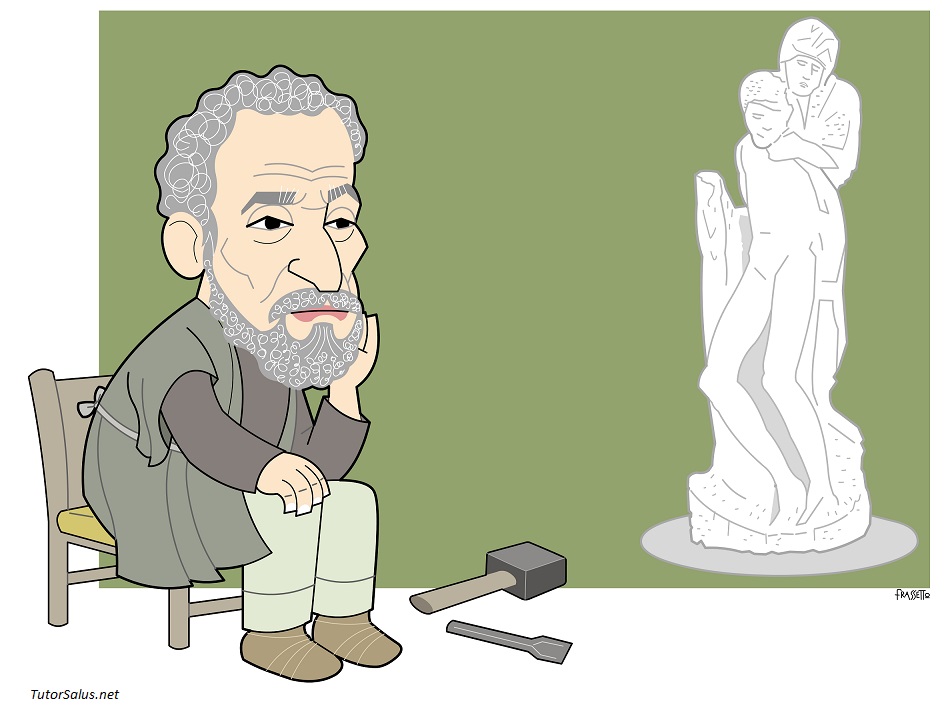Grand.[1]

Michelangelo Buonarroti thoughtful, next to his last, astonishing ‘Pietà’ (1552-1564) //
Original painting by Stefano Frassetto.[2]
It is the comfort-zone of removal : the same to which Michelangelo Buonarroti resisted all his life, to follow his own talent. Do we blame him ?
Would we then have given up to the extraordinary intuition of ‘Pietà’[3] where Mary is the hearted, far from any role, sentient to Christ, mourning without melancholy ?
And would we have given up to the unexpected flicker of Moses[4], powerful and so human when recognizing the uselessness of his own rage, also if facing with the stupid idolatry of those to him were entrusted ?
Painstakingly choose a raw material[5] which already includes a representation : but only Michelangelo could judge that marble block because no one else knew what he was drawing on the sheet, and what moved him making so eager, and listening to what. After scratching up to engraving, with an incomprehensible meticulousness which led him to correct, to move and then to take away take away, he finally touched the result which satisfies, a goal so many times gained to the removal temptation which instead persecuted him always.
Is removal legal ? Michelangelo worked all his life in the shadow of this temptation, hiding himself as before the looming of a totem which even we know is a puppet, just a symbolic one, nothing. Because removal demands naivety, not a destiny but it’s so dear.
Michelangelo was not a naive man, notwithstanding the pacifying submissiveness of naïvety tempted him so many times.
He had stopped being a commissioned sculptor, now he devoted himself only to painting which tired him less : but he still had that figure of a man in his head which he wanted to realize, and which he referred to Christ dead and thrown from the Cross, supported by a woman – his mother, who he almost didn’t know her[6] ? – and both struggling to their feet. However the two that he was extracting from the marble weren’t quite the same he had imagined at first : because she loomed and didn’t protect her son, she did weigh down on that now dead man. Michelangelo did realize that, when for the umpteenth time he was taking up something we couldn’t finish, but he didn’t go so far as to lie about a ‘grandness’ he hadn’t known of his own mother, and the ‘Pietà’ said ‘Rondanini’[7] did remain unfinished : it was not for lack of time.
The surrender of thinking to the lieing of removal, as a matter of fact doesn’t take into account that even a long-delayed duty, but not yet closely considered, is that it may not be humanly due.
Marina Bilotta Membretti / Cernusco sul Naviglio - April 19, 2023
[1] ‘Grand’ is the autobiographical novel of Noelle Mc Carthy, Penguin Random House New Zealand - 2022
[2] Stefano Frassetto is born in Turin in 1968. After his degree in Architecture at ‘Politecnico’ he begun as graphic novelist for local magazines. In the ‘90s he edited in France too, on ‘Le Réverbère’ and on ‘Libération’ : then he created ‘Ippo’ for ‘Il Giornalino’ and then the stripe ‘35MQ’ for the swiss magazine ‘20 Minuti’. In 2000 he came into ‘La Stampa’ as portraitist for cultural page and the insert ‘Tuttolibri’, then for the weekly ‘Origami’. Today he works also for the swiss magazine ‘Le Temps’. In 2022 he published his first anthology, ‘35mq: 2012-2022 Dieci anni di inettitudine’.
[3] ‘Pietà Vaticana’, created by Michelangelo in the white Carrara marble, between 1497 and 1499, is placed into the ‘Basilica di San Pietro in Vaticano’, in Rome.
[4] ‘Mosè’ was made by Michelangelo between 1513 and 1515 and then resumed in 1542 : it is placed into the ‘Basilica di San Pietro in Vincoli’, in Rome.
[5] Michelangelo Buonarroti (1475-1564) was born in a village on the hills near Arezzo from a family of Florence patricians which however was in difficult economic conditions : his passion for drawing and then for sculpting facilitated his apprenticeship at workshop where soon his father sent him, at first annoyed by his son preference for that ‘mechanical art’, as sculpting was called versus classical studies / ‘Michelangelo, Carrara e i Maestri di cavar marmi’, di Caterina Rapetti (2002), ‘Quaderni dell’Istituto di Storia della Cultura Materiale’.
[6] Second of five children, Michelangelo was orphaned of his mother at the age of six : since he was a newborn he was entrusted to a wetnurse, who belonged to a family of stonemasons and who raised him in the environment of the marble quarrymen at Carrara he often returned to, become a sculptor with clients, to choose personally the blocks of marble for his own works / ‘Michelangelo, Carrara e i Maestri di cavar marmi’, di Caterina Rapetti (2002), ‘Quaderni dell’Istituto di Storia della Cultura Materiale’.
[7] ‘Pietà’ said ‘Rondanini’ from the name of Marchesi Rondanini, who purchased it in 1744 to place it in their own ‘Palazzo’ in Rome : the work hadn’t a customer, as Michelangelo wanted it for his own burial, leaving the work just rough and never finished, even he had been sculpting it several times between 1552 and 1564 just before he died. The project is innovative indeed, because vertically designed by Michelangelo. Today you can admire it at the ‘Castello Sforzesco’ in Milan.